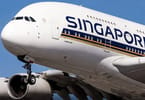DAKAR — Flying in Africa — then fasten your seatbelt, grit your teeth and hope for the best.
That could well be the advice of seasoned travellers familiar with the nightmare of making connecting flights, surprise stopovers and poor scheduling that is strangling trade and tourism on the continent.
Glenna Gordon, a freelance photographer based in Liberia, is well-versed in flights-gone-wrong.
A return trip to Monrovia from Cameroon once included a “surprise stop” in Libreville and then another in Mombasa, Kenya in east Africa, crossing the continent “from one ocean to another.”
The trip took about 30 hours.
“It would have been faster to take a pirogue (boat) across the Gulf of Guinea,” Gordon said.
While major international carriers are flocking to Africa for a slice of a vibrant and fast-growing market, local airlines are still hamstrung by complex restrictions between states and government interference 20 years after the ‘Yamoussoukro Agreement’ was supposed to open up the skies.
“Its purpose was to liberalise air services in the continent. It was a great idea but little progress has been made,” Anthony Concil, communications director for the International Air Transport Association, told AFP.
“Without the political will to support the industry?s growth, and the economic benefits that it will bring, the potential for improving connectivity is limited.”
Dubai’s Emirates is one of those expanding fast into Africa and in September launches the first direct flight from west Africa to Asia, from Dakar.
“It is not easy to travel around Africa, that’s for sure,” said Tim Clark, Emirates Airlines president.
“The European legacy has tended to dominate Africa and if you wanted to go from Accra in Ghana to Douala in Cameroon, about a 600-mile ((960 kilometres) flight, you have to go over Paris and we see that time and time again.”
Emirates is helping Senegal’s national carrier to relaunch after its collapse in 2009, which cut many key direct flights within west Africa from the regional hub.
“A good airline with more options of flying has an impact on trade and also on tourism and people moving freely,” said Ibrahima Cheikh Diong, chairman of Senegal Airlines.
According to Concil of IATA, 35 percent of goods traded internationally travel by air.
But with no clear vision by governments to develop aviation as a critical component of Africa?s infrastructure, “the continent pays the price in lost economic activity and higher costs to do business.”
Most African airlines are still state-owned and in cases where foreign investment is allowed, it is limited up to 49 percent with no management control.
“Often times, governments are not helping. The industry cannot operate like a normal business due to government intervention. And corruption is a problem in many parts of the continent,” said Concil.
The African airline industry ran up losses of 100 million dollars in 2008 and 2009 but was expected to make 100 million dollars this year due to strong traffic growth on the back of expanding commodities trade, according to IATA.
While demand in Africa grew 4.5 percent and 5.1 percent in 2007 and 2008, it fell 5.4 percent in 2009.
“It is expected to grow 13.5 percent this year, which is an exaggeration due to the comparison with an extremely weak 2009,” Concil told AFP.
While better organised highways in the sky are sorely needed, the main priority is still safety in the world’s most dangerous region for air travel which has an accident rate 14 times worse than the global average.
WHAT TO TAKE AWAY FROM THIS ARTICLE:
- “The European legacy has tended to dominate Africa and if you wanted to go from Accra in Ghana to Douala in Cameroon, about a 600-mile ((960 kilometres) flight, you have to go over Paris and we see that time and time again.
- The African airline industry ran up losses of 100 million dollars in 2008 and 2009 but was expected to make 100 million dollars this year due to strong traffic growth on the back of expanding commodities trade, according to IATA.
- While major international carriers are flocking to Africa for a slice of a vibrant and fast-growing market, local airlines are still hamstrung by complex restrictions between states and government interference 20 years after the ‘Yamoussoukro Agreement’.






















